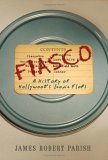Books Home / Entertainment Channel / Bullz-Eye Home
 Buy your copy from Amazon.com
Buy your copy from Amazon.com
| Fiasco: A History of Hollywood’s Iconic Flops
Publisher: Wiley (2006) Genre: Entertainment |
ALSO! Check out our interview with author James Robert Parish.
There’s something wonderful about a really, really bad movie…and if the movie costs a bundle and comes nowhere close to earning back its production costs, well, so much the better, really. Hollywood is notorious for its hubris and its belief that people will go see any old piece of crap they serve up…and, okay, given that “Big Momma’s House 2” pulled in more than 30 million bucks on its opening weekend, it’s pretty easy to see why they believe this. But, in “Fiasco: A History of Hollywood’s Iconic Flops,” author James Robert Parish provides 14 examples of when even the slack-jawed yokels who’ll go see anything wouldn’t spend their hard-earned money.
Yes, “Ishtar” is here. So is “Battlefield: Earth.” And “Showgirls,” and “Waterworld” (which shares its chapter with “The Postman”), and “Last Action Hero.” Parish goes into great detail about these films and more, from concept to finished product.
“Fiasco” is a bit bottom-heavy, offering a tremendous focus on films from 1980 onward, which is a mild shame, as the stories of the earlier motion pictures are more revelatory, having not been discussed as much in recent years. “Cleopatra” is already relatively well-documented, but Parish’s chapters on “The Chase” and “The Wild Party” are particularly interesting. The former managed to waste a cast that included Marlon Brandon, Jane Fonda and Robert Redford, described by Life magazine as “a disaster of awesome proportions,” while the latter proved that Merchant-Ivory films were not always the classy operation that they’re now considered to be.
The most interesting inclusion of the book may be “Town and Country.” It’s the most recent of the films Parish tackles, released in 2001, but it’s easily the most fascinating story. The original budget was $19 million; it ended up costing more than $85 million, then proceeded to only take in $10.37 million…and that’s including worldwide distribution, which has saved many a picture’s ass. Not this turkey, though. It wouldn’t have taken Nostradamus to predict that the film’s star (and one of the biggest reasons the budget skyrocketed in such a fashion), Warren Beatty, wouldn’t work in Hollywood again for a while. (As of this writing, he has yet to do another film.)
As with any book that only covers select films rather than attempt to tackle an entire genre, readers will no doubt find that some of their “favorites” have been passed over. (Personally, I was disappointed that “Howard the Duck” didn’t make the final cut.) Still, Parish has clearly made an effort to pick different types of films rather than stick with the usual suspects. Indeed, he makes a point of observing that some territory has already been well-trod – see “The Devil’s Candy” or “Final Cut” for the respective stories of “Bonfire of the Vanities” and “Heaven’s Gate” – and that his goal is to try and tackle some of the lesser-discussed (but just as terrible) bombs. Parish’s research is tremendous, his writing style generally breezy and imminently readable; occasionally, the background information he provides to set the stage for each film’s history requires a bit of trawling, but it’s inarguable that it still provides the journalistic equivalent of widescreen, providing the reader with the whole picture.
For better or worse, however, Parish has more than enough material for a sequel; it’s good because it’s something you should look forward to…but it’s bad because the possible inclusions are piling up even as you read this line.
~Will Harris
wharris@bullz-eye.com





